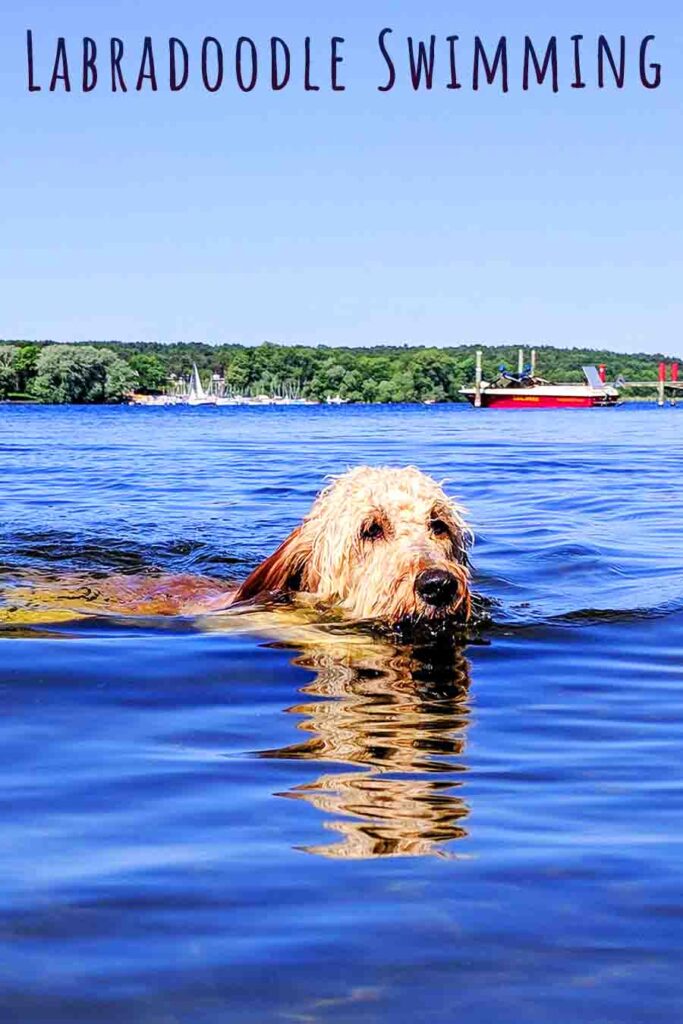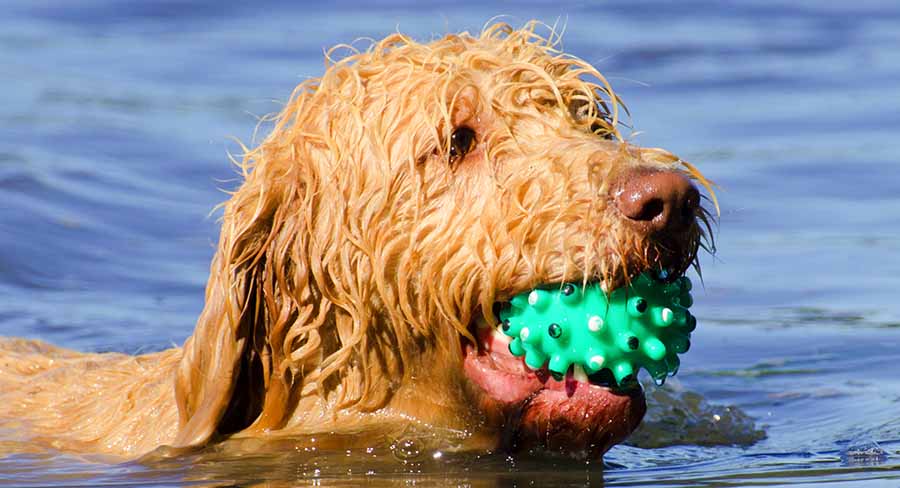If you’d like to get your Labradoodle swimming more often as part of their exercise regime, this article will help you choose the best places to do so, and keep them safe in the water.
- Do Labradoodles like to swim?
- Benefits of Labradoodle swimming
- Can Labradoodles swim in the sea?
- Can Labradoodles swim in a chlorinated pool?
- Choosing the best places for Labradoodle swimming
Labradoodle swimming can be a great way of keeping your dog in good physical condition, whilst also appealing to their ancestral instincts as water dogs. It’s likely that your Labradoodle will be a confident and enthusiastic swimmer, but it’s still important to know how to keep them safe in the water.
This adorable video shows Leo the Mini Labradoodle puppy finding his water legs for the first time. Let’s find out more about whether Labradoodles are designed for swimming, and how best to get them started.
Labradoodle swimming
Did you know that Labrador Retrievers and Poodles were both originally duck hunting dogs? Their job was to accompany a human hunter armed with a shotgun, and fetch the ducks or other game birds from where they landed after being shot. Since – being ducks – quite a few were shot over water, successful Labs and Poodles were also strong, confident swimmers.
In fact, they even have physical adaptations to help them move more easily in the water. Both breeds have webbed paws to paddle more efficiently, and it’s believed that Labs use their broad ‘otter’ tails as rudders to help them steer as they swim. The pompons on a traditionally clipped Poodle aren’t just a style statement either – they are positioned to allow maximum range of movement whilst keeping joints and vital organs warm.
Labradors and Poodles are still capable swimmers today, so it seems likely that Labradoodles should be too. Is this the case?
Do Labradoodles swim?
Yes! Most Labradoodles retain the Labrador’s and Poodle’s ability to swim. However, some Labradoodles are inevitably stronger swimmers than others. For example, Miniature Labradoodles are further removed from their most recent working ancestor, have less muscle mass, are out of their depth in shallower water, and are more affected by currents than Standard Labradoodles. This doesn’t mean that Miniature Labradoodles can’t swim – they’re just more likely to be disinterested in it.

Do Labradoodles like to swim?
Usually, yes! Even if it has been many generations since their ancestors last worked as duck-retrieving dogs, most modern Labs and Poodles today still have a strong affinity with water and enjoy swimming. So, their crossbred offspring tend to enjoy it too. However, every dog is an individual, with their own unique personality and preferences. Unsurprisingly then, some Labradoodles are more keen about swimming than others. Some factors which can shape how a Labradoodle feels about swimming include:
- Size, as we’ve already seen.
- Whether their parents were keen swimmers, or land lovers.
- Enjoyable exposure to shallow water before 12 weeks old.
- How they are introduced to swimming in deeper water.
- Positive and negative experiences with swimming.
- Their overall health and fitness.
Do Australian Labradoodles like to swim?
Australian Labradoodles are multigeneration Labrador Poodle crosses. The aim of Australian Labradoodle breeders is to establish their dogs as a new pedigree dog breed in their own right. The ancestry of Australian Labradoodles is still mostly Labradors and Poodles, but some other breeds (including Irish Water Spaniels) have also contributed to establishing the breed. Aussie Labradoodles come in three sizes: standard, medium and miniature. They are also very likely to enjoy swimming, but the larger sizes are more likely to be enthusiastic and confident about it, owing to their greater muscle mass.
Benefits of swimming for Labradoodles
Swimming is a great form of physical activity for Labradoodles!
- It keeps them in shape. Labradors and Labradoodles can be prone to weight gain and obesity. Incorporating lots of kinds of physical activity into their routine is an important part of keeping them at a healthy weight.
- It meets their need for physical stimulation. Labradoodles are dogs of action! They love games, work, fresh air and being on the move.
- And mental stimulation. Swimming challenges dogs to think about what they’re doing in different ways to when they’re moving on land. This demands focus and concentration.
- It’s low impact. Labs, Poodles and Australian Labradoodles all have have documented high frequencies of hip dysplasia. It’s probable that first generation Labradoodles do too, but data is less readily available. Swimming in very safe water is a great way for dogs with hip dysplasia to exercise gently without further damaging their joints.
- And it’s fun! The sight of a dog having fun in the water is enough to make any pet parent’s heart swell!
So, let’s look at how to get started.
Labradoodle swimming – How to get started
All dogs instinctively know how to swim, but making sure it is something they enjoy requires a bit of time and investment. Even if you don’t plan to take them swimming regularly, teaching them water confidence will be valuable if, for example, they ever fall into water accidentally.
Start during the socialization period
Your puppy is most receptive to forming positive opinions of new experiences when they are under 12 weeks old. So this is an ideal window in which to introduce them to water for the first time. Think small like your puppy though – shallow paddling pools, gentle streams, or a trip to the beach when the sea is very calm. Treat still water (ponds and pools) and moving water (rivers and the sea) separately, and make plans to introduce your young Labradoodle to both.
Be safety smart
If your dog or puppy is going to enter any body of water deep enough for them to get out of their depth (even if you have good intentions of staying in the shallows) then get them a ‘float coat’. Float coats are harnesses with buoyant panels to help keep your Labradoodle afloat.
Let your Labradoodle set the pace
Don’t press your puppy to go further into the water than they feel comfortable. Give them praise and treats for the progress they’ve made, and come back to try going deeper another day. Once they’re deep enough for their paws to leave the bottom, support them under their belly until they’re kicking and maneuvering confidently.
Keep them in sight
Always supervise your Labradoodle in the water, even once they’re full grown and swimming confidently.
Can Labradoodles swim in the sea?
Dog friendly beaches are great places to take your Labradoodle swimming. They are many dogs’ absolute favorite places on Earth! Some important rules to keep them safe in the sea are:
- Check the tide times before you let them go into the sea – a tide going out quickly can easily drag a dog along with it. Likewise, you don’t want to get stranded together by a tide that’s coming in!
- Don’t let them drink sea water or eat sand. Take fresh drinking water and offer it to them regularly.
- Rinse the seawater out of their coat as soon as possible, so they can’t lick it away.
Can Labradoodles swim in lakes and ponds?
For younger and smaller dogs, still bodies of water such as lakes and ponds have the advantage of no current. But precisely because they are stagnant, the water tends to be less clean. Blue green algae, which is toxic to dogs, also grows in still water in warm weather.
Before letting your Doodle swim in a lake or pond, check who owns it and whether it is safe to swim in. Rinse them thoroughly afterwards, and pay special attention to gently drying their ears. Labradoodles’ floppy, fluffy ears are real microbe-traps, and the warm, moist environment inside the ear is ideal for bacteria or fungi to flourish and turn into an infection.
Can Labradoodles swim in a chlorinated pool?
It is usually safe for dogs to swim in chlorinated pools, but take care to rinse their coat thoroughly with water from a tap afterwards. Labs and Poodles are both prone to sensitive skin, so monitor your Labradoodle closely for signs that chlorinated water is making their skin itchy or irritated.
Choosing the best places for Labradoodle swimming
Beaches, pools, and slow moving shallow rivers are all good places for dogs to swim. But here are some places to avoid:
- Reservoirs. Reservoirs look placid and inviting, but they can have strong currents under the surface. Because they’re deep, they also stay very cold even on a hot day, which can cause dogs (and people) to gasp in shock and inhale water.
- Rough seas.
- Fast moving rivers.
- Anywhere with signs prohibiting swimming.
Labradoodle swimming summary
Swimming is a fun form of exercise which is likely to appeal to your Labradoodle’s natural instincts. Lots of Labradoodles have a natural aptitude for swimming, but it’s wise to introduce any dog to swimming slowly and carefully, and always have their safety at the front of your mind.
Does your Labradoodle love to swim? Tell us about your favorite places to take them for a dip in the comments section down below
Before you go
Don’t miss these great resources, elsewhere on our site!
References
McGreevy et al. Labrador retrievers under primary veterinary care in the UK: demography, mortality and disorders. Canine Medicine & Genetics. 2018.
Pedersen et al. The effect of genetic bottlenecks and inbreeding on the incidence of two major autoimmune diseases in standard poodles, sebaceous adenitis and Addison’s disease. Canine Medicine & Genetics. 2015.
Tavares et al. Labrador retrievers are more attracted to water than to social stimuli: A pilot study. Journal of Veterinary Behavior. 2015.
Water Safety. PDSA. Accessed February 2022.

